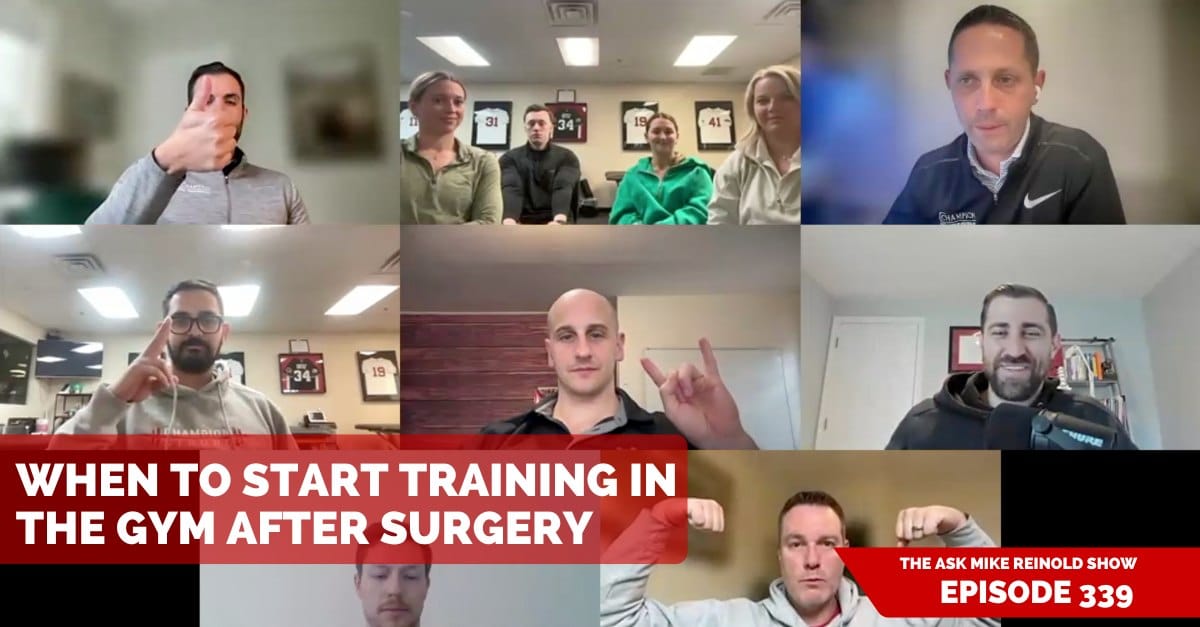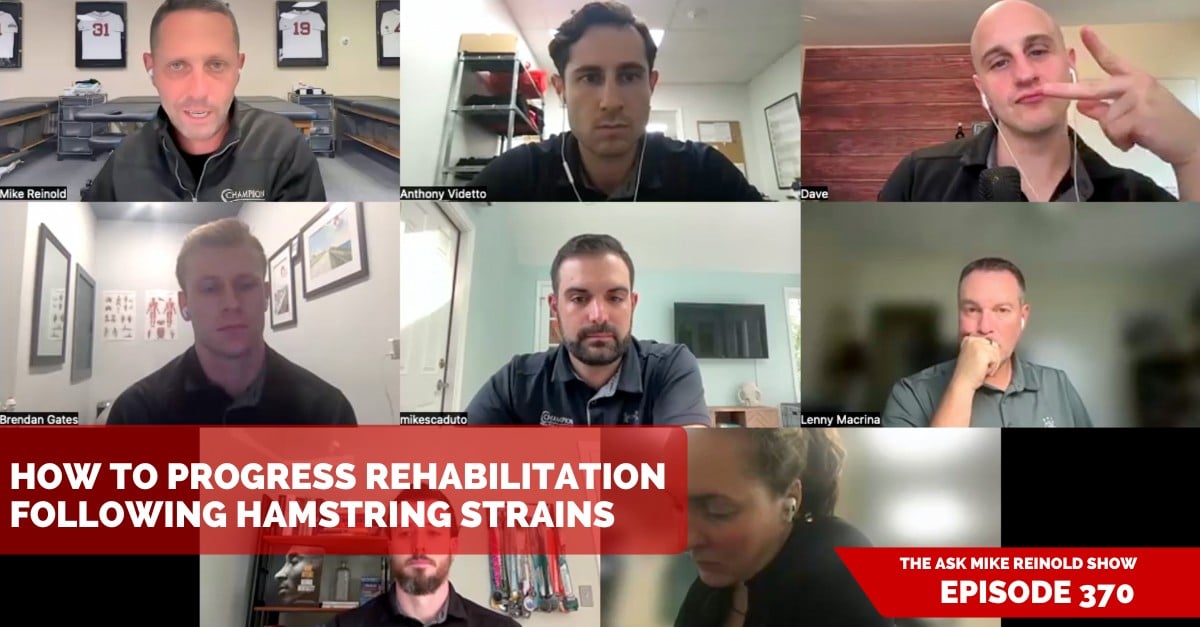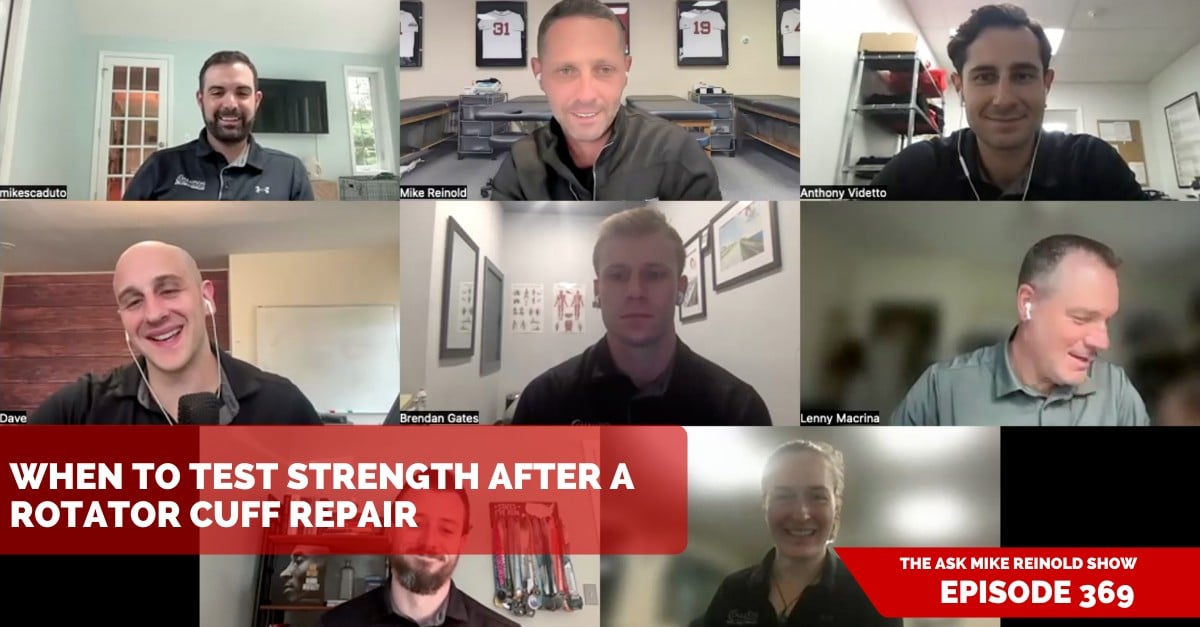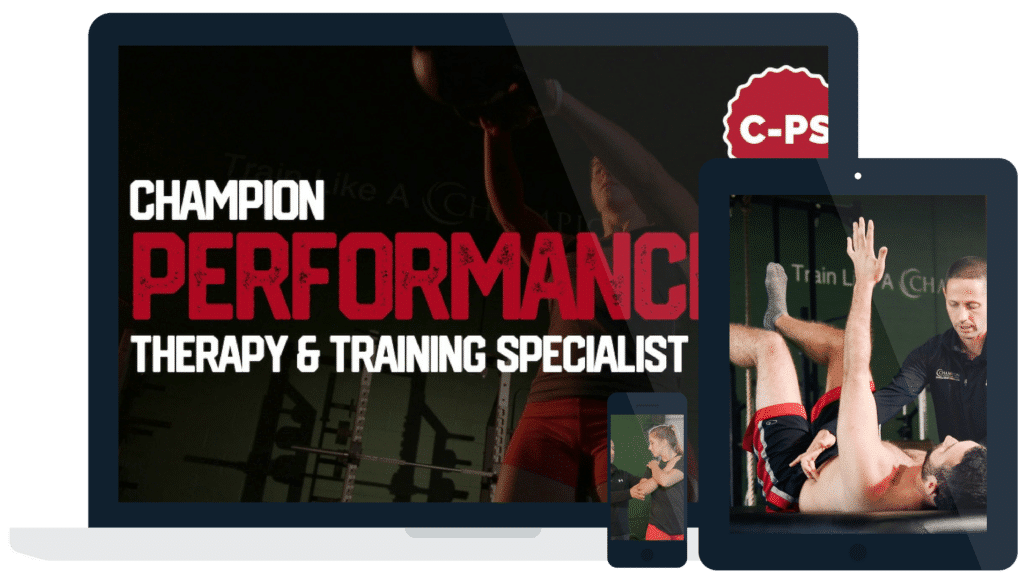Many people value getting back to the gym after surgery. They may be athletes needing to prepare for their sport or people who enjoy the gym recreationally.
We’re big advocates for getting back into the gym as soon as possible, but after surgery, there are some things to consider. Here are our thoughts on how to best manage this.
To view more episodes, subscribe, and ask your questions, go to mikereinold.com/askmikereinold.
#AskMikeReinold Episode 339: When to Start Training in the Gym After Surgery
Listen and Subscribe to Podcast
You can use the player below to listen to the podcast or subscribe. If you are enjoying the podcast, PLEASE click here to leave us a review in iTunes, it will really mean a lot to us. THANKS!
Show Notes
• Getting Back to Overhead Exercises in the Gym
Transcript
Sarah Catherine Martin:
David from California asked, “We’ve recently started collaborating with the strength and conditioning facility next to our PT clinic. When do you send your patients to a strength coach to start training in the gym after surgery?”
Mike Reinold:
Great question, David, I love it. This is probably a pretty common question in the PT world. When do you start training after a surgery? I think we have lots of examples. If your patient is a gym athlete or a fitness athlete of some sort, then the answer is going to be a lot different than a baseball player, for example, because that’s going to be some of their primary stuff.
Let’s start off with Dan because your patient’s objective is to get back in the gym. I feel like you’re going to have a good strategy for this, and then maybe we can talk about some sports stuff afterwards, too, with some of the athletes. But what do you think, Dan?
Dan Pope:
For sure. I’m just a big advocate of getting people back to what they want to do as fast as is safe. I think that’s going to depend a lot on the surgery.
It’s pretty common, let’s say in the CrossFit world, if someone has a SLAP repair or tenodesis or something. They’re probably safety bar squatting before they should, running before they should, doing all sorts of crazy stuff. It’s almost seen as a very positive thing that people are getting in as soon as possible. Sometimes it’s a little too quick for my liking, but the reason why is these folks love to be in the gym, and not being in the gym is very hard for them… And being fit and healthy is culturally a healthy thing, so they want to try to embody this. I agree that they should be getting to the gym as fast as is appropriate and safe, but you’ll also see folks that are two weeks after rotator cuff repair squatting, which we know is not a good thing. I do think that you have to be safe these folks and not get them back too quickly because more of a recent trend I’ve been seeing with social media.
But let’s say you do have, let’s say an ACL reconstruction or something along those lines, you should probably be getting in the gym and trying to work your upper body as soon as you’re able to. After a week or two of letting this thing calm down, getting in the gym, working your upper body in a safe way… You can’t be picking up heavy dumbbells and trying to drive with your legs in the bench press, you still have to be smart. If you guys have seen that viral video where someone retore his ACL while trying to do an incline dumbbell press, that stuff can happen, so we have to be really cautious. Maybe using more barbells in the gym with your upper body so it’s easy to load, so on and so forth, using smaller plates, which is going to drive Jonah crazy just because he doesn’t like it when there’s like a 10 with a five and then a 10 and then a five on top of it.
But being safe from that perspective, you can certainly train the contralateral limb as soon as you’re able to from a safe perspective. So I have these folks doing single-legged squat, single-legged deadlifts.
Essentially, you’re getting to the gym far before you’re doing much in the gym for the surgical side. And then to answer the question a little bit for the reader is that we actually get folks into the gym very quickly to start working on the side that has had the surgery, the involved side. But I think the big takeaway is that usually it’s the physical therapist that’s driving things. Let’s say I have a patient that’s, I don’t know, 12 weeks out from, let’s say a tenodesis or something like that. I feel pretty confident in their ability to do some basic strengthening with the upper extremity. And I can talk to Diwesh or Jonah and say, “We’ve already done these for four weeks. I think that they can start to do some of this within a strength conditioning program and feel free to train the lower body as much as you like. They still have maybe this or that as a contraindication,” but I’m pretty confident that the coach, at least at Champion, can handle that.
Usually, as we introduce new things, let’s say they’re now doing some upper body plyometric stuff, I do that for about four weeks or so as a physical therapist. I talk to Diwesh and say, “We’ve been doing these light and easy plyometrics for four weeks. I feel very confident for you to start programming them into the individual’s program as you see fit based on their sports goals,” so on and so forth.
At the end of the day, being very smart, knowing the specific surgery that the individual had so we don’t go and do anything stupid in the gym… But I always am a big advocate for doing more early on because I think it’s great for the athlete’s mental health.
And I think the other part is that we’re trying to drive a lot of these strength conditioning adaptations as much as possible at all times to improve performance. And having an injury is a great opportunity to work on other sport qualities. The problem is that if you delay improving some of these sport qualities, I think the big one is conditioning… Let’s say you do six months of all strength after ACL, and now we need to get someone’s VO2 max up, and the next, I don’t know, three months, it’s very, very tough. But if you start maybe someone early on bike work, and then as soon as they can, return to a run program, we’re starting to ramp those things up and you have strength and condition helping with that, and I think your return to sports will be a lot better.
Mike Reinold:
That’s awesome. Good stuff. No, that was perfect. I love it. That was great, Dan.
Let’s go to Jonah. I’m going to flip it a little bit. Typically, with an athlete, say a baseball player that had a shoulder, elbow surgery, something like that, we usually tell them, “you can get back in the gym as early as two weeks, start working on some other stuff.” Two weeks is pretty early, to be honest with you, and I often tell them two to four weeks. I’m happy in that range because it’s probably good to start moving, start feeling some stuff.
But Jonah, I’m going to throw it to you a little bit. We’ve been working together on one particular Tommy John recently, so I know it’s fresh in your head, but what are some of the things that you do with an athlete? How do you program them differently? What do you do with somebody that is 2, 3, 4 weeks after, say, an elbow surgery? What does that look like for you? Because I think hearing it from the strength coach’s perspective, what it looks like that might open some PTs’ minds about things that they can do like, “I didn’t realize that’s how you do it or we could do that.” Why don’t you explain a little bit about what you would do with an athlete two weeks out of a surgery, Jonah?
Jonah Mondloch:
I think the first thing in my mind is at that point we’re really just trying to set up our base for what’s to come in the future, where we don’t have to rush to anything. If they’re coming back, especially for something like an ACL or Tommy John, it is a really long rehab process, so we don’t have to try to rush to do anything crazy. Safety obviously comes first.
But at the same time, I want to try to do as much as I can to train the unaffected limbs. One piece is taking advantage of different types of equipment that you have. Things like safety bars for a Tommy John become really important, where a lot of the lower body exercises we’ll do will be with a Tommy John, obviously your squats, your split squats. But then even if we want to work on a hinge pattern, a light safety bar can be a good option because something like an RDL is something you won’t be doing for quite a while with the grip strength demands of that. Exercises like hip thrust, we’ll use more often than we probably would otherwise. It’s finding ways to still load those same muscles or same movement patterns that take all the stress away from the affected side.
And then, another big piece that Dan touched on at the end is this is a really good time to work on certain qualities that we might not have a chance really to work on with an athlete who’s always just trying to get ready for their next season.
Base level conditioning can be a big one where I think that’s going to help long-term with their ability to recover. A lot of our typical athletes, I think, stay away from general aerobic conditioning, but I think there’s some benefit to using that extra time to work on mobility work and things like that as well.
Just finding ways to really train all the same qualities we would otherwise, but because of that long-term picture, it might change our focus a little bit, and then modifying everything necessary to take stress off. Another one is we can do some jumping work pretty early on, but staying away from arm swinging because that’s just unnecessary at that point.
Mike Reinold:
Lots of modifications that you can do training around the injury. There’s tons of stuff. There’s no doubt in my mind that the athletes that we have that go back to the gym and embrace it early, tend to recover better. They just seem to. Maybe they’re more dedicated, maybe they’re more into it, but they seem to recover better.
Diwesh, any other thoughts from your perspective in the gym?
Diwesh Poudyal:
Yeah, I think Dan and Jonah covered pretty much all of it. The one thing that I’ll speak to is, it’s almost like from the strength coach’s end of having a beat. Something that’s exciting is we don’t often have a long time with athletes where we get nine months straight to work on building their athletic qualities or make physiological change. When we get athletes that we know for a fact they’re not going to be back in their sport for nine months, let’s say after Tommy John, that’s nine months to make a lot of change. I love reverse engineering the process of “this person’s supposed to be back to throwing and back to pitching off the mound in nine months competitively.” What are all the big things that I can develop over the course of the nine months, and what is it that they want to accomplish when they are back to sport?
I want to really understand their goals and essentially work backwards from that goal and lay out a nine-month plan mentally and say, “Here’s where I want to be. Here’s how we’re going to get there.” The PT is going to help on the upper body side of things, if it’s Tommy John that we’re speaking about. But as far as all the other lower body athletic qualities, the strength, the power, the elasticity, if it’s all that, I want to really reverse engineer the entire nine months and lay out a good periodized plan and not just write the next month’s programming.
Mike Reinold:
I love that. Such a good, unique opportunity for a lot of athletes. That’s why a lot of athletes that… There’s a lot of anxiety and depression and stuff that was like, “You’re not contributing to your sport, your team, your bad teammate now,” that sort of thing. This is their way to say, “I am still working every day to get better. I’m going to come out of this ahead.” I think that’s so good mentally for them to embrace.
As a PT, it still stinks. We have a gym and a PT clinic and we’ll see people that go to PT for six months after ACL and then come to the gym and they’re like, “We hope the doctor clears us in a month or two.” But they’ve just been doing basic baseline PT in a clinic with curtains and stuff for six months. They’re so behind, they’re so behind when you do that. People need to realize this. You need to collaborate with strength coaches and the gym to be able to do that.
I want to end with a question. I’m going off script here. We don’t have a script, but I’m going off it anyway. I’m going to ask you a question because this is a PT thing. I feel like I’ve seen this, I’ve heard this in here. How would you answer this, when somebody says, “Well, I don’t want to work the uninvolved side” because it’s just going to make their asymmetry worse. “Mike, your weak, involved limb will stay weak, but you’ll get the other one way too strong.” How do you guys answer that? I’d love to hear some thoughts on that. Who wants to jump in on that one?
Lenny Macrina:
I deal with this a lot.
Mike Reinold:
PTs will say that. Len, you start then. I know others will want to jump in, but how would you answer that?
Lenny Macrina:
I treat a lot of ACLs and I think a common misconception out there by doctors, too, is, “I just need symmetry in their limb symmetry index. If I can get them within 10% of the other side, that’s the goal.” I’m like, “Yes, but if we have to bring the good side down so that the involved side doesn’t have to go up as much, that’s not the goal.” We want it…
Mike Reinold:
Maybe that’s our problem.
Lenny Macrina:
Honestly, I’ve had this conversation numerous times on social media and in person, and I love these guys. I love you and I think you know who we’re talking about because we talk a lot.
But I think it’s a philosophical difference in how I think. Maybe me as a PT and other professionals see that. You get cross symmetry, you get cross communication, so that’s going to help the uninvolved side and you’re just trying to maximize the person’s ability to get strong overall. Why do we want to bring the good side down to have symmetry when we can bring the good side up and now give the involved side a really high goal to get back to? And now you’re maximizing the person’s ability to be strong and powerful and elite at their sport. And we probably will decrease their injury risk in the long-term because we know ACL tears, for example, probably one in four will retear their ACL at some point, especially the other side, like the uninvolved side. Maybe that’s why the uninvolved side is always implicated after an ACL is because we don’t work it enough. Because the philosophy has always been, “let’s just get symmetry in our LSI and don’t worry about how we get there.”
I take a different approach. I work both sides. I’m literally constantly saying that to students and other PTs if they can do, I don’t know, a 26-kilogram goblet squat, single-leg on the uninvolved side, maybe if they’re only doing 20 on the involved, we always have to adjust the weight if we’re doing single-limb stuff. Talk to Mike Boyle, he’s a big advocate of this. I’ve learned a lot from just following him on Twitter, and I think that’s a huge component of what we miss as PTs, is just agreeing with that old philosophy. So definitely no.
Mike Reinold:
You underscore the need here, at least for me, that it’s not just about symmetry. I mean, we should have some norms based on whatever body weight, size, sport, athlete, whatever, those sorts of things. You can’t just do that. You don’t want to be symmetrically crappy. That’s a tweet line. You can tweet that. That’s not it. That was pretty good.
Anybody else have anything on that? Because I just think that is a question people hear. Anybody want to add in on that or we feel pretty good with Len?
I like it. Good job.
Diwesh Poudyal:
Pretty good.
Mike Reinold:
Don’t be symmetrically crappy, David from California.
Awesome. Great stuff. Really appreciate the question. Great job everybody. Thanks so much. If you have a question like that, head to mikereinold.com, click on that podcast link, and ask away. And please, subscribe, Apple Podcast, Spotify, so you get notifications of the new episodes and we’ll see you on the next one. Thanks so much.






